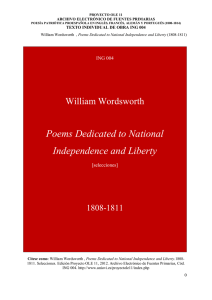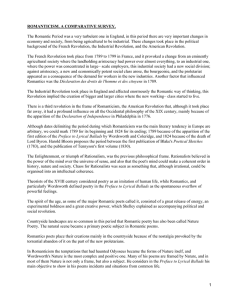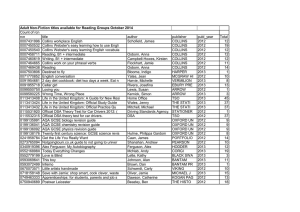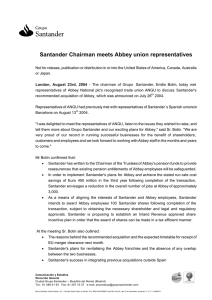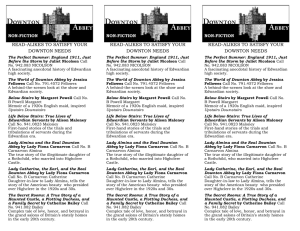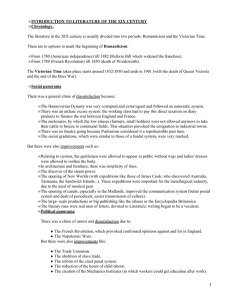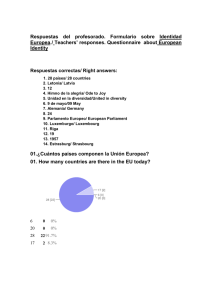maqueta miscelanea 34 - Miscelánea: A Journal of English and
Anuncio
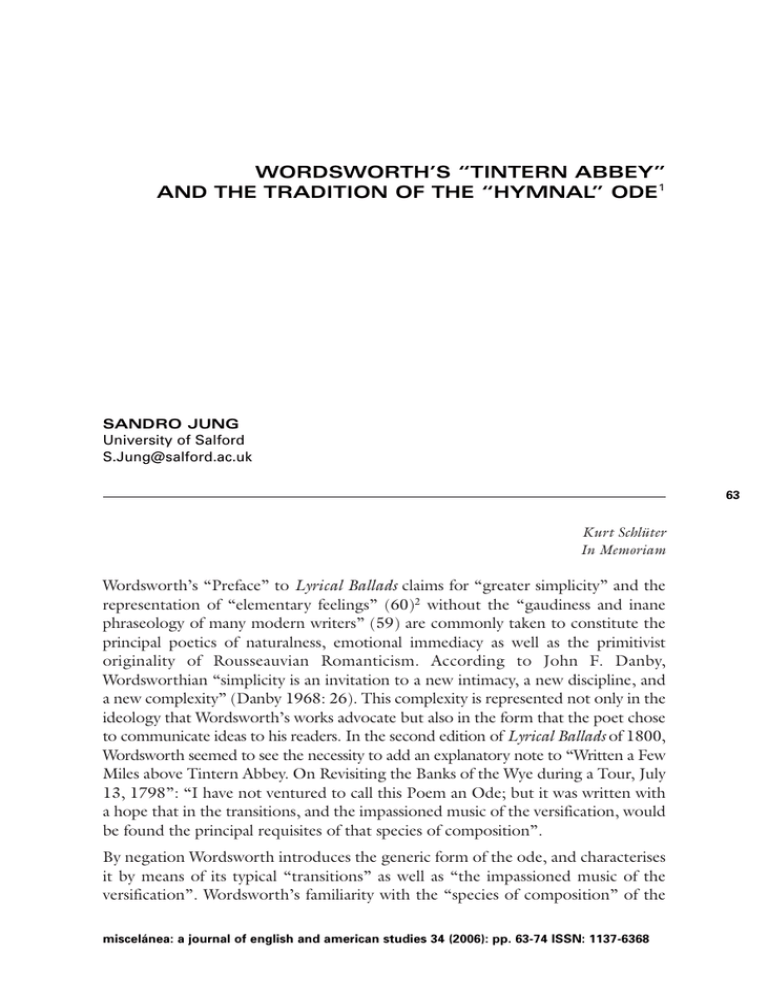
WORDSWORTH’S “TINTERN ABBEY” AND THE TRADITION OF THE “HYMNAL” ODE1 SANDRO JUNG University of Salford S.Jung@salford.ac.uk 63 Kurt Schlüter In Memoriam Wordsworth’s “Preface” to Lyrical Ballads claims for “greater simplicity” and the representation of “elementary feelings” (60)2 without the “gaudiness and inane phraseology of many modern writers” (59) are commonly taken to constitute the principal poetics of naturalness, emotional immediacy as well as the primitivist originality of Rousseauvian Romanticism. According to John F. Danby, Wordsworthian “simplicity is an invitation to a new intimacy, a new discipline, and a new complexity” (Danby 1968: 26). This complexity is represented not only in the ideology that Wordsworth’s works advocate but also in the form that the poet chose to communicate ideas to his readers. In the second edition of Lyrical Ballads of 1800, Wordsworth seemed to see the necessity to add an explanatory note to “Written a Few Miles above Tintern Abbey. On Revisiting the Banks of the Wye during a Tour, July 13, 1798”: “I have not ventured to call this Poem an Ode; but it was written with a hope that in the transitions, and the impassioned music of the versification, would be found the principal requisites of that species of composition”. By negation Wordsworth introduces the generic form of the ode, and characterises it by means of its typical “transitions” as well as “the impassioned music of the versification”. Wordsworth’s familiarity with the “species of composition” of the miscelánea: a journal of english and american studies 34 (2006): pp. 63-74 ISSN: 1137-6368 Sandro Jung 64 ode reflects his reading of the major odes of the mid-century. In the “Preface” he commended Collins who, by Romantic poets, was universally associated with the ode and whose rare first edition of Several Descriptive and Allegoric Subjects (1746) Wordsworth possessed.3 In his 1793 “Remembrance of Collins” he imitated the poet’s Ode on the Death of Mr Thomson. Clearly, Wordsworth was aware of the (generic and ideational) distinctness of “Tintern Abbey”; at the same time, he utilised conventions that were used by Collins but modified them significantly in his poem so that —while giving voice to his cult of Nature— the classical Hellenism that inspired Collins was no longer discernible. Collins’s odes had not developed a “religion of nature” (Piper 1962: 60) as Wordsworth’s poems did, but he embedded his personifications in a framework of myth that enabled him to build, in the form of the ode, a sublime setting in which his speakers invoked the central deities of the compositions.4 While Collins invoked emanations of Goddess Natura, Wordsworth provided a personalised version of this all-comprising deity which was not defined in mythological terms. Yet, even Wordsworth attributes a mysticism to Nature that Collins saw as an inherent aspect of his deities. Wordsworth’s association of his poem with the genre of the ode is unavoidable since the ode —most prominently since the mid-eighteenth century, and especially through the renewed interest in Longinus and John Dennis’s treatise on the sublime— is a lyric genre that deals with the sublime, the superhuman, supernatural, and the divine. Collins had already left behind the encomiastic function that seventeenth-century odes —especially music odes— had utilised, and Wordsworth does not revive this function, either. Kurt Schlüter demonstrated in Die englische Ode: Studien zu ihrer Entwicklung unter Einfluß der antiken Hymne that the structure of Collins’s hymnal odes consisted of three distinct parts: (i) the initial invocation of the deity, (ii) the ‘pars epica’, a narrative part dedicated to providing information (mythological or contextual) on the deity and its importance for the speaker, and (iii) a petition, usually, for inspiration. Schlüter considered the invocation as the most important part, since it established the relationship between speaker and deity; for that reason, he does not consider “Tintern Abbey” a hymnal ode, arguing that the manner of Wordsworth’s encounters with the divine is essentially different from the experience of the mythical gaze, despite his utilising the word vision (see Schlüter 1964: 182).5 He concedes, however, that there are features in Wordsworth’s particular way of experiencing the divine which in their representation stand in a relationship of tension with the hitherto known form of the ode (Schlüter 1964: 181).6 Groundbreaking though it was —and still the best history of the English ode— his study aimed to trace the history of the hymnal ode by means of concentrating on the major representatives. Recent research, as well as the revision of the poetic canon, reflects a new interest in those authors hitherto ignored or miscelánea: a journal of english and american studies 34 (2006): pp. 63-74 ISSN: 1137-6368 Wordsworth’s “Tintern Abbey” and the Tradition of the “Hymnal” Ode neglected. In that respect, it must be acknowledged that the hymnal ode lived on after the publication of Collins’s and Gray’s odes but that the strict formula that Schlüter introduced was at times translated into a tripartite structure of strophe — antistrophe— epode, while others applied a reductivist poetics and held that the hymnal invocation was the only essential component part of the ode (see Jung 2006). In Wordsworth’s use of the genre of the ode the Thou-I relationship of traditional hymnal odes in which the speaker depreciates his own identity by apostrophising the “Thou” is inverted into the Romantic constellation of I-Thou. There are brief invocations in “Tintern Abbey” of “sylvan Wye” which, however, are integrated in the long contemplative passages of recollection. Wordsworth primarily used the pars epica not to describe the deity but himself in order to put into context the lengthy recollections of the speaker’s experiences and sensations. One of the central topics for Wordsworth is that of recollection; the spontaneous response to the power of Nature that he may have felt when first visiting Tintern Abbey could have been uttered by means of a hymnal apostrophe; recollection, however, is a process that has already used the synthesising (inspiring) qualities that a successful petition would have conferred on him. Through his central emphasis on recollection, therefore, Harold Bloom argues, “Wordsworth so mystifies memory as to make it the one great myth of his antimythological poetry” (Bloom 1985: 113), thereby introducing mythic qualities that are inherent in the hymnal tradition. In that regard, “Tintern Abbey” “becomes more memory than spiritual or imaginative renovation” (Bloom 1985: 116). The poem adopts the epic features that Pindar’s Epinician odes possessed, as well as the modal correlations that were introduced in the long poem and will, later in Wordsworth’s career, be employed in The Prelude. Unlike Pindar or Collins, however, Wordsworth does not represent the history of heroes (Pindar) or the aretalogy of his personifications (Collins), but is more concerned with a desire to re-narrate his own history, the history of his mental and poetic growth. In doing so, the pars epica in “Tintern Abbey” is transformed into an autobiographical recollection of his visit to the abbey while at the same time redefining the ode as a Romantic lyric genre that no longer requires the superior deity in order for the speaker to be granted the petition that is usually the subject of the apostrophe. Rather than seeing “Tintern Abbey” as a failed hymnal ode, it represents a decisive alternative to the mythological odes of the mid-century; Alastair Fowler, writing about genre, insists that generic “features are often characteristic through their absence” (Fowler 1982: 73). And in Wordsworth’s poem the striking absence of the invocational petition —the central address of the deity— is silently taken for granted and echoed in his mention of Nature as his personal guide, guardian and mother, functions that Collins (similarly, if more hesitantly) attributed to Goddess Natura in his odes. miscelánea: a journal of english and american studies 34 (2006): pp. 63-74 ISSN: 1137-6368 65 Sandro Jung 66 The title mention of Wordsworth’s “revisiting the banks of the Wye” indicates that his composition draws on the memory of a past visit and combines this —through imaginative synthesis— with his present visit to the abbey. The force of “the spontaneous overflow of powerful feelings” (Wordsworth “Preface”: 62) is translated into durable (and artful) form. His technique of recollecting and reconstructing the past through transforming a transient, unstable, and fragmented memory of past impressions into a lasting memory that functions as the backbone of Wordsworth’s (moral) well-being and identity as a poet appears not to be based on a plan other than Wordsworth’s immediate response to revisiting Tintern Abbey. It is, therefore, an impression of immediacy and spontaneity that he wants to create. Wordsworth’s imagination does not merely recollect the past, but refines both the memory as well as the sensations first experienced. Although, as Mary Jacobus argues, the process of recollection concentrates the “beautifully controlled movement of the verse” with the “mood” (Jacobus 1976: 48) of “tranquil restoration”, thereby assuming that Wordsworth only serves as mouthpiece of his imagination, she realises at the same time that this process of translating thoughts and memories into writing requires some ordering of ideas, associations, connectives and transitions which reflect the artistry of Wordsworth’s poem. Michael Mason further helpfully reminds the reader that “Tintern Abbey” “was not written confronting the scene it describes or even ‘composed’ there. [...] The date furnished in the title confirms the Fenwick note, as this was the day on which Wordsworth returned with Dorothy from his walking tour of the summer of 1798” (Mason 1994: 205). The “introspective recall” that is so central to Wordsworth’s recollection of past experience is reflected in his “rhythms of thought —associative exploratory, fluctuating in and out of the present” (Jacobus 1976: 50). The poet uses the fragmentary and elusive qualities of the ode to bridge the conflict between original experience and recollected experience; this experience, through the process of poetic composition, becomes “durable” and “permanent”. Steven Knapp is certainly right, in that regard, that the necessity to order the elements of memorable experience that constitute the hymnal pars epica can only be achieved through reflection, for “only in the tranquil perspective of a later moment can the unwarranted excitement of the original experience be recognised as an index of the mind’s transcendence through illusion of supernatural circumstances” (Knapp 1985: 108). Marshall Brown reads “Tintern Abbey” in terms of the poet’s construction of experiential and imaginative growth and, in his reading, traces “an interpretation of empiricism” in which “Wordsworth recomposes the genesis of his current maturity” (Brown 1993: 40). Wordsworth successfully creates the impression that the reader is tracing his progress over the five years that have elapsed since the poet’s last visit to the abbey. When Wordsworth visited Tintern Abbey for the first time, his perception of the miscelánea: a journal of english and american studies 34 (2006): pp. 63-74 ISSN: 1137-6368 Wordsworth’s “Tintern Abbey” and the Tradition of the “Hymnal” Ode environment was synchronic, focusing on the individual “spots of time”. In order to achieve coherence within the pars epica of his odic composition he needs to synthesise these “spots of time” by means of an artificial sequence. The diachronic progress of the pars epica, however, need not necessarily be authentic or logical; rather, it makes use of transitions and digressions, elements so characteristic of the ode since Cowley and anticipates what F. W. Bateson, dealing with the later poetry of Wordsworth, discusses in terms of the egotistical sublime (see Bateson 1954: 150-153). This Wordsworthian “emphasis on the special nature of art-activity” (Williams 1983: 36), despite his centring on his own mental growth, is a prominent feature of Collins’s odes, too, where the speaker describes his quest in search of poetic inspiration to translate his creative energy into Coleridge’s “esemplastic power” (see Jung 2005). The narrated time (erzählte Zeit) of “Tintern Abbey” comprises five years, which are alternately termed “Five years” and “five summers”, relating again to Wordsworth’s personal growth from a rationalist to a devotee of Nature who perceives and understands even time only by means of reference to the seasons and natural change. While the deity-personifications that are used in the hymnal odes of Collins had been part of the mythological machinery for thousands of years, Wordsworth’s experience is not embedded within the mythological context of antiquity but in that of the myth of Nature and his desire to be to her prophet. Importantly, and that is a further difference from Collins, “Wordsworth adds another dimension to the dimensions of space and the dimension of time, for he presents the scene to us as interpenetrated with human feeling” (Durant 1970: 88). Rather than providing a linear progression of time in the pars epica, however, the poet’s dealing with time appears to be circular, for as Charles Sherry observes, “the landscape remembered in bitter times in the city is a restorative; it is a source of freedom from the harshness of life, not that it enables him to escape it, but that it prevents him from succumbing to it” (Sherry 1980: 98). Yet, even after his (imaginative) return to Tintern Abbey through the fictionalised permanence of the completed pars epica Wordsworth will have to return home, for his life does not end with the end of the poem. Unlike Collins’s speaker, Wordsworth’s does not inhabit the environment that Collins’s deities do; it may, therefore, be argued that they and their spirituality permeate the landscape, whereas Wordsworth —through the association of “Tintern Abbey” with the hymnal ode tradition— hopes to gain the sense of permanence for which Collins’s speaker strives continuously. Collins, however, aims to achieve a union with the emanations of Goddess Natura while Wordsworth, through his recollective capacity, is self-contained and reworks external impressions internally. The sublime, frequently considered as the prerequisite and defining feature of the ode, is representationally reflected in Wordsworth’s descriptions of the natural miscelánea: a journal of english and american studies 34 (2006): pp. 63-74 ISSN: 1137-6368 67 Sandro Jung environment at the abbey, that is, the “steep and lofty cliffs” (l. 5) which appear to be implanted into this “wild secluded scene” (l. 6). Wordsworth hopes that in this solitude of sublimity he will be able to find the “absolute essence of truth and feeling” (Hazlitt 1960: 86). In that respect, Wordsworth, as William Hazlitt suggested, “takes the simplest elements of nature and of the human mind, the mere abstract condition inseparable from our being, and tries to compound a new system of poetry from them” (Hazlitt 1960: 87). 68 Apart from the need for Wordsworth to find a place of “more deep seclusion” (l. 7), he aims to conquer his anxiety. Paradoxically, seclusion and solitude enable him to hold communion with Nature as well as relieve his anxiety and fear of forgetting. Drawing on the images of the “Immortality” ode he suggests that it is through recollection that he can bring back impressions and feelings long forgotten. The “utter nakedness” of forgetfulness and its disintegrating characteristics are counteracted by his selfassertive act of recollection. In that regard, Bernard Groom comprehends “Tintern Abbey” as “a panoramic vision of the power of the remembered landscape working under the surface in a mind perplexed with five years of inward conflict; and, by implication, a record of the creative instinct triumphing over the forces of disintegration (see Groom 1966: 33). In other words, Wordsworth’s speaker in his hymn on Nature and his account of his own growth resolves (at least temporarily) the “threat of a loss of vitality and happiness” that Michael Mason considers as the “groundwork” of “Tintern Abbey” (Mason 1994: 206). The dialogic structure that is indicated formally through the invocation and the petition is alluded to at the beginning of the poem where Wordsworth uses an interjective opening which, as is later revealed through his address of the Wye, is addressed to the river rather than being what Bateson understands as a “reverie”.7 As in the case of Collins who used metonymy frequently, Wordsworth conceives of the Wye as an emanation of the force of Nature. In that respect the repetition of “once again” (l. 4) in line 14 emphasises the personal relationship of the speaker with Nature. The paratactical syntax employs “again” several times to depict the speaker’s unchangeable delight at beholding again what he had already seen five years before. In fact, the scene that Wordsworth is so eager to establish in terms of the picturesque is not real, but derives from those images that he has stored in his memory and which are then combined and perfected by his imagination. Thomas de Quincey, focusing on the central importance of Nature for Wordsworth and the poet’s association of Nature with universal memory, observes that Wordsworth existed only “through his commerce with nature” (de Quincey 1960: 40). In the imaginatively conjured environment of Tintern Abbey, the speaker is able to experience “long months of ease and undisturbed delight” (Wordsworth Prelude: 1: 26) which in reality were originally —that is, on the occasion of his miscelánea: a journal of english and american studies 34 (2006): pp. 63-74 ISSN: 1137-6368 Wordsworth’s “Tintern Abbey” and the Tradition of the “Hymnal” Ode actual visit— no more than a “few passing moments” (Moorman 1957: 403). His measuring of time is influenced by his emotions and is therefore imaginatively prolonged. Rather than embedding his narrative within the mythical pars epica of Collins’s odes, the mythological machinery becomes unimportant and is replaced by Wordsworth’s authority to evoke (and create) a world of memory, thereby achieving what Collins’s speakers did not.8 The internalisation of memories and their metamorphosing recollection are seen as ways out of the dilemma of cultural progressivism. Pessimistically, however, Wordsworth is aware that he will ultimately have to return to society and to adopt his social function again. Mark Foster comments on the metaphor of the hermit that the poet assumes in his imaginative “reveries” and remarks that the hermit “represents not simply transcendence or any achieved realisation, but rather an ideal of decisive action and coherent relation” (Foster 1986: 85), a harmony that Wordsworth attempts to establish through his response to Nature; his speaking authority, as has already been indicated, ought therefore to be understood as his version of the fulfilment that Collins gained (in uncertain terms) through his invocations. The recollection of memories and the translations of them into “reveries” enable Wordsworth to experience “sensations sweet” (l. 27) (see Jung 2003: 36-43). In that regard, recollective introspection produces a pleasing and soothing effect on him, which he feels “in the blood” but also “along the heart” (l. 28). The memory of these scenes has become essential to his being: These beauteous forms, Through a long absence, have not been to me As is a landscape to a blind man’s eye. (ll. 22-24) The result of the experience of “sensations sweet” is the “spontaneous overflow of powerful feelings” which, he notes in the “Preface” to Lyrical Ballads, takes its origin from emotion recollected in tranquillity: the emotion is contemplated till [...] the tranquillity gradually disappears, and an emotion, kindred to that which was before the subject of contemplation, is gradually produced, and does itself exist in the mind. (62) His “purer mind” (l. 29), that is, the place where all impressions and sensations are collected, collated and imaginatively purified, becomes the instrument of “tranquil restoration”; despite its epistemological inaccuracy, this recollected result of “tranquil restoration” —with its central component of the imagination— “reveals an important kind of truth” (Bowra 1966: 7). Wordsworth, in that regard, confesses that he owes “this blessed Mood” (l. 37) to Nature who helps him to cope with “the heavy and the weary weight / Of all this unintelligible world” (ll. 39-40). In other words, sublimation of mundane life is effected by means of miscelánea: a journal of english and american studies 34 (2006): pp. 63-74 ISSN: 1137-6368 69 Sandro Jung 70 imaginative processes. It is this form of mental (imaginative) escapism that has helped the speaker to withstand the “fever of the world.” “Tintern Abbey” poetically argues for Nature’s ability to calm and soothe the human mind by providing the necessary impressive stimuli that are, in turn, reworked by the poet’s imagination. It is these stimuli that reveal “amongst fields and mountains a substitute religion” (Willey 1950:272) to Wordsworth. Nature possesses a therapeutic character and assists Wordsworth in softening his Zivilisations-Klaustrophobie (see Göller 1963: 343). Nature’s goodness is expressed in her “healing thoughts / Of tender joy” (ll. 144-145) which act like a balm on the poet’s strained sensibility. As a “worshipper of Nature” (l. 152) Wordsworth is confident that Nature will not forget him to whom “these steep woods and lofty cliffs / And this green landscape [are] / More dear, both for themselves and for thy [Nature’s] sake!” (ll. 157-159). This confidence and trust in Nature satisfy the poet “that he can get all the wisdom he needs from the world of nature as revealed by the senses” (Durant 1970: 104). Nature, Wordsworth notes, is the “anchor of my purest thoughts, the nurse, / The guide, the guardian of my heart, and soul / Of all my moral being” (ll. 109-111). Nature is no longer assigned the role of a superior being (as Collins did to Goddess Natura) but is seen as part of Wordsworth, finding an emanation in Dorothy Wordsworth. He defines Nature by means of attributes that would usually have formed part of the aratological description of the deity in the hymnal ode but appropriates them to his own mental growth. The speaker understands the spirit of Nature as omnipresent and identifies it in the character of a companion who advises him on how to lead his life. In the poem it becomes less and less possible to know whom he is addressing: Logically, in line 114 he would still be addressing Nature; contextually, however, it can be inferred that he invokes Dorothy, creating a deliberate ambiguity that can similarly be found in Collins’s odes. This is an instance of what Bateson comprehended as the “concessions to irrationality” and the “logical contradictions” of the poem (see Bateson 1954: 141, 142). The closeness of his relationship with this companion (Dorothy —but, grammatically, also Nature) is expressed in his emphatic interjection “my dearest Friend, / My dear, dear Friend” (ll. 115-116), an address that is reminiscent of the hymnal address, despite Wordsworth’s breaking down of all differences of status by collapsing the mythological and unreachably divine character of Nature and by approximating his own existence to that of his “guardian” and “guide.” The hitherto public odic character of “Tintern Abbey” is here inverted, too, by his turning to his sister and announces Wordsworth’s shift “to a more private poetry” (Bateson 1954: 145). The interjective “Oh” then establishes without doubt that he is now addressing his sister, revealing that “prayer” (l. 121) will be rewarded by Nature, as “Nature never did betray / The heart that loved her” (ll. 122-123). In short, miscelánea: a journal of english and american studies 34 (2006): pp. 63-74 ISSN: 1137-6368 Wordsworth’s “Tintern Abbey” and the Tradition of the “Hymnal” Ode [Nature] can so inform The mind that is within us, so impress With quietness and beauty, and so feed With lofty thoughts, that neither evil tongues, Rash judgements, nor the sneers of selfish men, Nor greetings where no kindness is, nor all The dreary intercourse of daily life, Shall e’er prevail against us, or disturb Our cheerful faith, that all which we behold is full of blessings. (ll. 125-133) With the aid of Nature, Wordsworth’s memory reconstructs and newly creates “all sweet sounds and harmonies” (l. 142). Nature, too, “will undertake to teach the speaker to prevent the destruction and forgetfulness of his recollections” (Willey 1950: 272, 277). Or, in Susan C. Meisenfelder’s words, “Nature taught him not by offering platitudinous moral systems but by guiding perception, eliciting feelings, by teaching him ‘to see, to think, and feel’” (Meisenfelder 1988: 9). Then, that is, in the 1790s, “the exercise of his imagination was primarily a source of pleasure, mingled with a melancholy awareness that what was imagined had to remain a dream, a fancy of nothingness” (Christiansen 1988: 150). Reaching poetic maturity, however, the poet has succeeded in capturing the impressions of the past imaginatively and turned them into permanent and lasting reminders of the happiness he used to experience in his communion with Nature. With maturity Wordsworth has realised the true importance of memory and the imagination: For I have learned To look on nature, not as in the hour Of thoughtless youth; but hearing oftentimes The still, sad music of humanity, Nor harsh nor grating, though of ample power To chasten and subdue. (ll. 88-93) The dialectic of inevitable change and conjured permanence is central to “Tintern Abbey.” Max Byrd, in that respect, speaks of the speaker’s “shifting identities” (Byrd 1983: 26) and refers to his personal and artistic development. In a hymnal sense, what Willey terms the “divinization of Nature” (Willey 1950: 253) results in the poet comprehending Nature both as divine and his muse. There is no distinction between Nature’s divinity and her functions as guardian and companion any more, and this marks the poet’s innovation within the hymnal tradition. Through his address of Nature, Wordsworth looks for ways of “how to reestablish that parallel permanence, how to be reabsorbed into steadying interdependence” (Byrd 1983: 30). His imaginative reworking of the past “is not so much recollected miscelánea: a journal of english and american studies 34 (2006): pp. 63-74 ISSN: 1137-6368 71 Sandro Jung 72 as created, as a speculative refuge from the pressure to realise oneself in poetry” (Foster 1986: 88). Fred V. Randel argues that “Tintern Abbey” “is about living among ruins” (Randel 1993: 380). Wordsworth was living among the ruins of the awareness that his (actual) past was irreparably lost to him. He was eager to construct a state of mind which had not yet “establish[ed] an identity separate from the world around” (Byatt 1997: 162) it. In the process, he wanted to rid his mind of the awareness that he is a “prisoner of mortality” (Byatt 1997: 163). Referring to what Willey called the “divinization of Nature”, Marjorie Levinson argues that one of the central points why Wordsworth may have decided to avoid writing specifically about Tintern Abbey in the poem may have been his wish to exclude religious, and more precisely Christian thought, from his poem (see Levinson 1986: 15). Levinson does not realise that, notwithstanding Wordsworth’s resistance to call his poem “ode,” he was in fact using and inverting some elements such as the invocation and the pars epica that Kurt Schlüter regarded as essential in the hymnal ode. That he did not adhere to the poetic practice of Collins can be explained with his different concerns: he was not a poet in search of a mythic gift of vision, but —possessed of Fancy— he succeeded in constructing that for which Collins (vainly) apostrophised deities such as Eve and Simplicity. Wordsworth was deeply rooted in the literary traditions of the eighteenth century, but he saw the need for generic experimentation to differentiate his voice from those of his predecessors. The hymnal tradition could still be used by a variety of Romantics such as Mary Robinson, Keats and Shelley but they had a classicist agenda rather than advocating the views of a “worshipper of Nature” (l. 152) (see Jung 2002: 185-197). miscelánea: a journal of english and american studies 34 (2006): pp. 63-74 ISSN: 1137-6368 Wordsworth’s “Tintern Abbey” and the Tradition of the “Hymnal” Ode Notes 1 . I would like to acknowledge my gratitude to Professor Frederick Burwick for a critical reading of and helpful comments on an earlier version of this article. wesentlich verschieden von dem Erlebnis der mythischen Schau, obwohl er sie gelegentlich mit den Worte vision bezeichnet”. Translations mine. 2 . The “Preface” and “Tintern Abbey” will be cited from Mason 1994. 6 . There are “in Wordsworths besonderer Weise, das Göttliche zu erleben, Züge, die mit der Darstellung in der bisher bekannten odischen Form in Spannung stehen”. Translations mine. 3 . This copy is now in the Piermont Morgan Library, New York. 4 . Gray, on the other hand, in his odes demonstrated encyclopaedic learning, annotation, as well as poetic diction, features that are irreconcilable with Wordsworth’s aspiration to represent the language and sentiments of “common men.” 5 . “Die Art seiner [Wordsworth’s] Begegnungen mit dem Göttlichen ist 7 . Bateson is not aware of the generic association that “Tintern Abbey” has with the hymnal tradition, especially as he considers them poem in terms of a monologue. See Bateson 143. 8 . On the importance of memory in the hymnal ode, see Jung “Some Notes” 176-81. Works cited BATESON, F.W. 1954. Wordsworth: A ReInterpretation. London: Longmans. BLOOM, Harold. 1985. “The Scene of Instruction: Tintern Abbey”. In Harold Bloom. (ed.). Modern Critical Views: William Wordsworth. New York: Chelsea House Publishing. BOWRA, Maurice. 1966. The Imagination. Oxford: Oxford U.P. Romantic BROWN, Marshall. 1993. “Romanticism and Enlightenment”. In Stuart Curran. (ed.). The Cambridge Companion to British Romanticism. Cambridge: Cambridge U.P. BYATT, A.S. 1997. Unruly Times. Wordsworth and Coleridge in Their Times. London: Vintage. BYRD, Max. 1983. “Metamorphosis and Tintern Abbey: Two Notes”. Modern Philology 81 (1): 24-37. CHRISTIANSEN, Rupert. 1994. Romantic Affinities: Portraits from an Age, 1780-1830. London: Vintage. DANBY, John F. 1968. The Simple Wordsworth: Studies in the Poems 1797-1807. London: Routledge and Kegan Paul. QUINCEY, Thomas. 1960. “Essays on Wordsworth”. In David Nichol Smith. (ed.). Wordsworth. Poetry and Prose. With Essays by Coleridge, Hazlitt, de Quincey. Oxford: Clarendon Press. DE miscelánea: a journal of english and american studies 34 (2006): pp. 63-74 ISSN: 1137-6368 73 Sandro Jung DURANT, Geoffrey. 1970. Wordsworth and the Great System: A Study of Wordsworth’s Poetic Universe. Cambridge: Cambridge U.P. FOSTER, Mark. 1986. “Tintern Abbey and Wordsworth’s Scene of Writing”. Studies in Romanticism 25 (1): 75-95. FOWLER, Alastair. 1982. Kinds of Literature: An Introduction to the Theory of Genres and Modes. Oxford: Clarendon Press. 74 —. 2006. “Form versus Manner: The Pindaric Ode and the ‘Hymnal’ Tradition in the MidEighteenth Century.” LiLi: Zeitschrift für Literaturwissenschaft und Linguistik 36 (144): 30-45. KNAPP, Steven. 1985. Personification and Sublime: Milton to Coleridge. Harvard: Harvard U.P. LEVINSON, Marjorie. 1986. Wordsworth’s Great Period Poems. Cambridge: Cambridge U.P. GÖLLER, Karl Heinz. 1963. “Die geistige Entwicklung Wordsworths”. Die neueren Sprachen 12: 341-53. MASON, Michael ed. 1994. Lyrical Ballads. London and New York: Longman. GROOM, Bernard. 1966. The Unity of Wordsworth’s Poetry. New York: St. Martin’s Press. MEISENHELDER, Susan C. 1988. Wordsworth’s Informed Reader: Structure and Experience in His Poetry. Nashville, Tennessee: Vanderbilt U.P. William. 1960. “Essays on HAZLITT, Wordsworth”. In David Nichol Smith. (ed.). Wordsworth. Poetry and Prose. With Essays by Coleridge, Hazlitt, de Quincey. Oxford: Clarendon Press. JACOBUS, Mary. 1976. Tradition and Experiment in Wordsworth’s Lyrical Ballads. Oxford: Clarendon Press. MOORMAN, Mary. 1957. William Wordsworth: The Early Years. Oxford: Clarendon Press. PIPER, H.W. 1962. The Active Universe: Pantheism and the Concept of Imagination in the English Romantic Poets. London: The Athlone Press. RANDEL, Fred V. 1993. “The Betrayals of Tintern Abbey”. Studies in Romanticism 32 (3): 379-397. JUNG, Sandro. 2002. “Some Notes on the Hellenism of Mary Robinson’s Odes”. Eighteenth-Century Women 3: 185-197. SCHLÜTER, Kurt. 1964. Die englische Ode: Studien zu ihrer Entwicklung unter Einfluß der antiken Hymne. Bonn: Bouvier. —. 2003. “‘Sweetness’ in the Poetry of William Collins”. English Language Notes 41 (3): 36-43. SHERRY, Charles. 1980. Wordsworth’s Poetry of Imagination. Oxford: Clarendon Press. —. 2004. “Some Notes on William Mason and His Use of the ‘Hymnal’ Ode”. Studia Neophilologica 76 (2): 176-181. WILLEY, Basil. 1950. The Eighteenth-Century Background. Studies on the Idea of Nature in the Thought of the Period. London: Chatto and Windus. —. 2005. “Post-Augustan Nature in William Collins’s Ode to Evening (1746)”. Philologia 3: 97-106. WILLIAMS, Raymond. 1983. Culture and Society. London: The Hogarth Press. Received: 24 November 2006 Revised version: 19 January 2007 miscelánea: a journal of english and american studies 34 (2006): pp. 63-74 ISSN: 1137-6368
